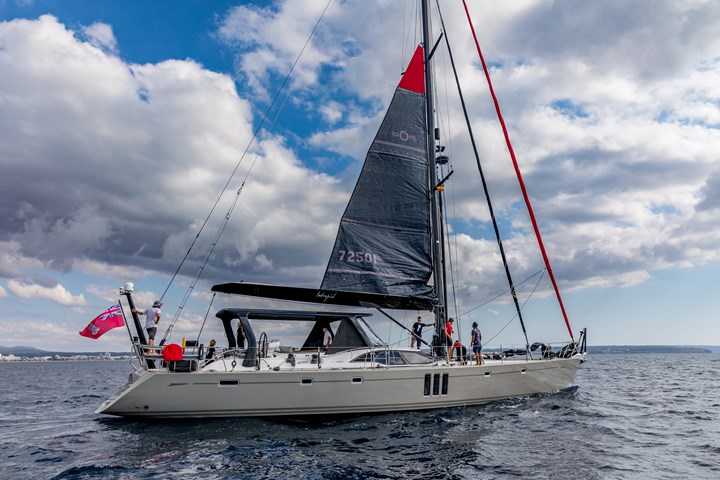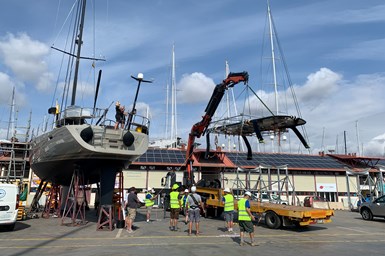BMComposites installs solar-powered composite hardtop bimini for expedition yacht
Contracted hardtop bimini uses a combination of carbon fiber, glass fiber and foam core as well as 20 SP130 solar panels for a highly sustainable and sleek boat design.

Finished hardtop is shown here on its first sea trial in Palma Bay. Photo Credit: Oyster Yachts
Providing expertise in structural and cosmetic composite work in the superyacht industry, BMComposites (Palma, Spain) was contracted by Oyster Palma (Spain), on behalf of its client, S/Y Intrepid, to design and build a composite hardtop bimini, or deck cover, for the Intrepid 22-meter Oyster 725 model yacht. In addition to using lightweight composite construction, BMComposites was tasked with integrating solar panels into the design concept.
It was clear to the company that sustainability had to be approached as a design challenge — aside from the technology, BMComposites says the hardtop had to meet aesthetic requirements, while also providing minimal weight gain for the boat to maintain speed and performance. However, the critical factor that drove the decision to use solar power was to improve the range of the boat — ultimately to be able to sail further without refueling. This was especially important for an expedition yacht like Intrepid, which often ventures off the beaten track.
The composite hardtop developed for S/Y Intrepid uses a hybrid of carbon and glass fiber with Corecell Marine foam core from Gurit (Newport, U.K.). In addition to solar panels, LED lighting and state-of-the-art speakers were integrated into the design. The hardtop was painted anthracite black to match the modern look of the yacht and features 20 SP130 solar panels. According to BMComposites, the SP130 series panels were chosen, both because the back-contact monocrystalline silicon cells reach a record 24% conversion of sunlight into electricity — giving a total power of 2.6 kilowatts — while also adding to the aesthetic appearance of the yacht. Intrepid now only needs to use the yacht’s generator for thirty minutes every few days and can travel for two months without stopping to refuel compared to every two weeks before using solar.
The new hardtop installation was reported to be seamless, and the sea trial went without a hitch. “This was a challenge, but our team delivered an amazing result and the communication between the owner of Intrepid, Oyster Palma and ourselves flowed well, which was the key to the success of the project,” says Mark Branagh, managing director of BMComposites. “We look forward to more work in renewables, as the course of composite construction continues to evolve.”
Related Content
-
Carbon fiber, bionic design achieve peak performance in race-ready production vehicle
Porsche worked with Action Composites to design and manufacture an innovative carbon fiber safety cage option to lightweight one of its series race vehicles, built in a one-shot compression molding process.
-
ASCEND program update: Designing next-gen, high-rate auto and aerospace composites
GKN Aerospace, McLaren Automotive and U.K.-based partners share goals and progress aiming at high-rate, Industry 4.0-enabled, sustainable materials and processes.
-
NCC leads composites manufacturing phase of eXtra wing demonstrator
Key structural elements for a 6-meter section of the Airbus biomimetic wing were undertaken by NCC engineering specialists to produce 28 one-off flying parts.













